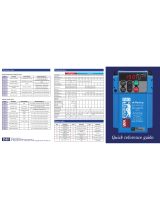
ix
Chapter 6 SELECTING PERIPHERAL EQUIPMENT
6.1 Configuring the FRENIC-Mini................................................................................................................. 6-1
6.2 Selecting Wires and Crimp Terminals....................................................................................................... 6-2
6.2.1 Recommended wires........................................................................................................................... 6-4
6.2.2 Crimp terminals................................................................................................................................. 6-12
6.3 Peripheral Equipment ............................................................................................................................. 6-13
6.4 Selecting Options.................................................................................................................................... 6-20
6.4.1 Peripheral equipment options............................................................................................................ 6-20
6.4.2 Options for operation and communications ...................................................................................... 6-33
6.4.3 Extended installation kit options ....................................................................................................... 6-37
6.4.4 Meter options .................................................................................................................................... 6-40
Chapter 7 SELECTING OPTIMAL MOTOR AND INVERTER CAPACITIES
7.1 Selecting Motors and Inverters................................................................................................................. 7-1
7.1.1 Motor output torque characteristics..................................................................................................... 7-1
7.1.2 Selection procedure............................................................................................................................. 7-4
7.1.3 Equations for selections ...................................................................................................................... 7-7
7.1.3.1 Load torque during constant speed running ................................................................................ 7-7
7.1.3.2 Acceleration and deceleration time calculation........................................................................... 7-8
7.1.3.3 Heat energy calculation of braking resistor............................................................................... 7-11
7.1.3.4 Calculating the RMS rating of the motor .................................................................................. 7-12
7.2 Selecting a Braking Resistor................................................................................................................... 7-13
7.2.1 Selection procedure........................................................................................................................... 7-13
7.2.2 Notes on selection ............................................................................................................................. 7-13
Chapter 8 SPECIFICATIONS
8.1 Standard Models ....................................................................................................................................... 8-1
8.1.1 Three-phase 200 V series .................................................................................................................... 8-1
8.1.2 Three-phase 400 V series .................................................................................................................... 8-2
8.1.3 Single-phase 200 V series ................................................................................................................... 8-3
8.1.4 Single-phase 100 V series ................................................................................................................... 8-4
8.2 Semi-standard Models .............................................................................................................................. 8-5
8.2.1 EMC filter built-in type in three-phase 400 V series........................................................................... 8-5
8.2.2 EMC filter built-in type in single-phase 200 V series ......................................................................... 8-6
8.3 Common Specifications............................................................................................................................ 8-7
8.4 Terminal Specifications .......................................................................................................................... 8-11
8.4.1 Terminal functions ............................................................................................................................ 8-11
8.4.2 Location of terminal blocks............................................................................................................... 8-19
8.4.3 Terminal arrangement diagram and screw specifications.................................................................. 8-20
8.4.3.1 Main circuit terminals ............................................................................................................... 8-20
8.4.3.2 Control circuit terminals............................................................................................................ 8-22
8.5 Operating Environment and Storage Environment ................................................................................. 8-24
8.5.1 Operating environment...................................................................................................................... 8-24
8.5.2 Storage environment ......................................................................................................................... 8-25
8.5.2.1 Temporary storage..................................................................................................................... 8-25
8.5.2.2 Long-term storage ..................................................................................................................... 8-25
8.6 External Dimensions............................................................................................................................... 8-26
8.6.1 Standard models ................................................................................................................................ 8-26
8.6.2 EMC filter built-in type..................................................................................................................... 8-32
8.7 Connection Diagrams ............................................................................................................................. 8-37
8.7.1 Keypad operation .............................................................................................................................. 8-37
8.7.2 Operation by external signal inputs................................................................................................... 8-38
8.8 Details of Protective Functions............................................................................................................... 8-39
























